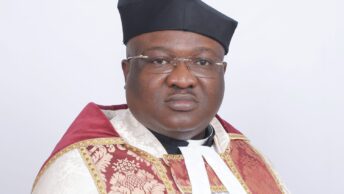(My Right to Respond)
By Ven. David C. Nwanekpe, D.D
Chaplain, Council of Knights and Ladies (CONNAM, USA)
Rector, Anglican Church of the Holy Spirit, Bronx, NY
Introduction
I appreciate your enthusiasm in analyzing the viral burial video, but as clergy and defenders of apostolic order, we must evaluate such matters with liturgical discipline, canonical wisdom, and theological integrity — not mere sentiment or circumstantial justification.
Let me address the issues raised — respectfully but firmly — with sound references from Anglican canon law, ecclesiastical precedent, and global Anglican practice.
1. Is the Cassock an “Everyday Clerical Wear”?
You described the cassock as “clerical wear” suitable for burial activities such as lowering coffins and even jumping into graves. However, this view is fundamentally flawed and inconsistent with both Anglican theology and canon law.
Yes, the cassock is clerical wear — but it is not casual wear. It is a sacred garment symbolizing ordination, humility, prayer, and consecration. It must be treated with reverence — not used for manual labor or undertaker duties.
🔹 Canon B8 of the Church of England:
“A minister shall wear such vesture as has been authorized… especially during the performance of Divine Service and when engaged in public ministry.”
🔹 Canon 10 of the Church of Nigeria:
Regards the cassock as part of the sacred identity of the clergy — not designed for manual or non-liturgical functions.
Using the cassock for grave labor violates its symbolic dignity. If it is sacred enough for the altar and prayer house, it must be respected equally in public.
2. Clergy at Burial: Liturgical Role, Not Manual Labor
Let us be clear: the Book of Common Prayer prescribes the clergy’s role at burials as spiritual, not manual:
“The Priest shall say: ‘Man that is born of a woman hath but a short time to live…’ Then shall follow the committal: ‘Earth to earth, ashes to ashes, dust to dust…’”
Nowhere are clergy required to carry or lower coffins. That is a manual and customary role — usually for laypeople or undertakers.
🔹 Canon B38 (Church of England):
“No minister shall presume to alter or innovate any rite or ceremony prescribed in the Book of Common Prayer…”
Clergy entering the grave or acting as undertakers is not part of prescribed duties, regardless of intention.
3. Ecclesiastical Order Across Anglican Provinces
In global Anglican practice, including:
- The Church of England
- The Episcopal Church (USA)
- The Anglican Church of Kenya, Uganda, South Africa
- The Church of Nigeria
…clergy preside over funerals with prayers and committal. Physical burial is the work of undertakers or kinsmen.
Liturgical procession ≠ Manual labor.
The first is symbolic. The second is not clerical.
Even in Eastern Orthodox and Roman Catholic churches — no clergy jump into graves, even for Popes or Archbishops.
4. Wrong Actions Do Not Become Right by Repetition
You stated, “They didn’t do anything wrong because they used what was available to them.”
With respect, that logic is theologically flawed.
“A wrong does not become right simply because you lacked tools. Repetition does not make error true.”
Anglican liturgy is not based on improvisation — but order, reverence, and sacramental symbolism.
If tools were lacking, someone other than clergy should have stepped in. Necessity is not permission for disorder.
5. Motives Behind Defending Error
Some defend these actions to seek favor from higher church authorities or to appear loyal. But truth is not about loyalty or emotion:
“Truth is not tribal. It is not decided by emotion or ambition.”
“A priest’s first loyalty is to God, not to ecclesiastical politics.” (Galatians 1:10)
We must speak the truth — in love, but without fear.
6. A Theology of Clerical Dignity
Clergy are not undertakers. The ministerial role is spiritual.
Our consecrated hands are for the Word, the Sacraments, and the Blessing — not for ropes and graves.
Even in Igbo culture, burial duties belong to kinsmen, not priests. A priest’s role is to pray, not labor.
Confusing these offices disrespects the dignity of the priesthood.
Postscript: A Word of Withdrawal — Yet a Stand on Ecclesiastical Order
After reading responses to my earlier reflection, I wish to clarify:
I acknowledge that in Nigeria, many priests see this practice as a mark of honor or brotherhood. If it is now accepted in their cultural or diocesan context, that is their prerogative.
However, this does not make it canonically correct or align it with global Anglican standards.
Even if clergy from other parts of the world appear in photos lowering coffins, visuals do not validate theology.
Our benchmark must remain canon law, liturgical tradition, and the sacred office of the priesthood.
I withdraw any personal offense caused — but I stand by the truth:
“The priesthood must be preserved with dignity. Certain roles are best left to those to whom they rightly belong.”
Conclusion
✅ The cassock is sacred and should never be used inappropriately.
✅ The clergy’s burial duty is liturgical, not manual.
✅ Canon laws of both the Church of Nigeria and Church of England affirm this.
✅ The global Anglican Communion upholds clerical dignity in all public roles.
✅ Sentiment, repetition, or lack of tools do not justify breaking liturgical order.
Let us preserve the dignity of our priesthood, and return to the reverence that our Anglican identity demands.
May we honor God with our conduct — both in life and in death.
Grace and Peace,
David Nwanekpe







